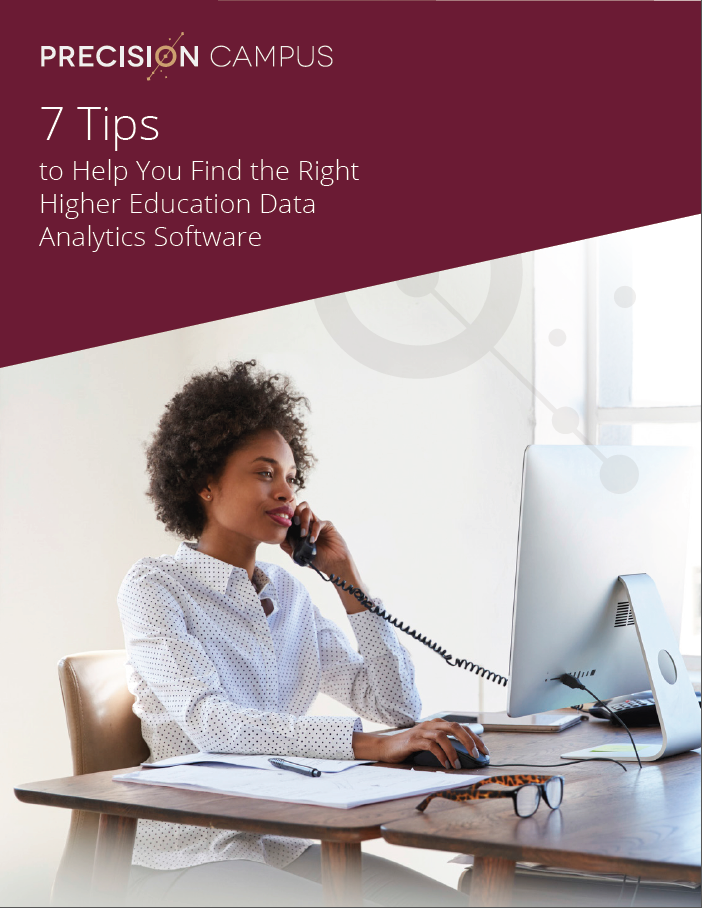Think about all the different data sets your school has. From student GPAs to class section counts, nearly everything can be put into a data set, creating a culture of big data. How are you using all of this information to your school’s advantage?
When used strategically, big data and data analytics in education has the power to transform an institution. As a professor of higher education at North Carolina State University and a previous director of institutional research, Stephen Porter knows this first-hand. “Institutions are rushing with their analytics and not thinking strategically about what data they have and how it can help their predictions,” Porter said.
What is Big Data?
The term “big data” refers to the immense amount of information that’s created and collected on a daily basis. Big data has become so colossal that traditional data management tools, like Excel spreadsheets and manual record-keeping, are no longer able to keep up.
Because the volume of data has significantly increased with the digital revolution, the need for a robust data analytics program is an absolute must if you want to put your information to use in a strategic way.
In particular, educators can use data analytics to record and analyze the following data sets:
- Student Data: Demographics like age, ethnicity and gender; whether they are full-time or part-time; if they take classes online, on campus or a mix of the two.
- Course Data: Enrollment headcounts, grades and completion rates by program or section.
- Instructor Data: Demographics like age, ethnicity and gender; salary information; productivity levels.
- Facility Data: Classroom utilization and resource allocation, like how many hours a week each room is being used.
Benefits of Using Data Analytics Tools
- Create a Data-Driven Decision-Making Culture – With data analytics, there’s no need to rely on blind faith when making decisions. You’ll have numbers and statistics to back up your decisions, which can lead to more successful outcomes.
- Access Data Easier – Data analytics tools depend on the same type of technological infrastructure to capture, store and organize information, so it’s easy to find what you need.
- Find Information More Quickly – Since your data lives in one place, there’s no need to search through dozens of files and folders to find one report, making the process much quicker.
With these in mind, we’ve compiled a list of some of the most effective ways educational institutions can leverage their data analytics.
Help Your Students Succeed
Enrolling a new student is far more expensive than retaining a current one. That’s why one of the most advantageous ways to use data analytics in education involves identifying challenges students may have or are currently having in their academic career.
Predicting Success
When determining which students to accept to your institution, looking at certain academic analytics can tell you which candidates are the most likely to succeed and which may be more likely to drop out or fail their classes. This can help you make a judgment call before they even walk onto your campus.
Say a student was accepted to your institution and wants to study engineering. By using data you already have about this student — like their SAT scores, high school GPA and individual class grades — you can assess whether or not they would be likely to succeed in the engineering program. Did they struggle with math? If so, the engineering track might require additional math support for this particular student. In this instance, the student can meet with their advisor to review other options, like exploring a different program or beginning with remedial math courses.
Help Students Who May Be Struggling
Your data can also help you intervene before a problem has the chance to become a serious issue for you and your students. If a student fails their classes, placing them on academic probation at the end of a semester doesn’t help anyone. But by sharing certain learning analytics between professors and advisors throughout a term, steps can be taken to prevent the student from failing in the first place.
Porter has seen institutions leverage this technique in practical ways. “With the right data and software program, institutions can set up an alert system that notifies a student’s advisor if they are failing their classes,” he said. “The advisor can then intervene and try to find a solution, which is a much more proactive approach compared to just letting a student fall through the cracks.”
Do they need tutoring? Are they struggling to balance their personal life with school? Or are they just in the wrong program? Their advisor will be able to assess the situation and figure out a solution that will benefit both the student and your institution.
Share a Public Fact Book
Deciding on where we pursue our education is one of the biggest decisions we make in our lives, and students spend months — if not years — researching their options. Because of this, data analytics in education is useful when it comes to recruiting and educating applicants.
Assembling data sets into a public fact book that’s accessible on your website is a great way to share information that your prospects need to make a decision. This can include data like:
- Tuition
- Class sizes
- Student to teacher ratios
- Student outcomes
The example below shows the course success rates for French classes. In 2015, the success rate was 61% but it jumped to 83% in 2016. This data would give a student who wants to study French a good idea of how successful the program is, which may make them more likely to attend your institution.
See how customizable reporting software could help you leverage your institution’s data. >>
Evaluate How Physical Space is Being Used
From classrooms to energy consumption, physical space is costing you money. But fortunately, your data can help you make efficient use of every square inch of your campus.
Tracking Resources
Where are your students at specific times of the day and days of the week? If your data tells you that they aren’t very excited to take English courses on Friday afternoons, you can potentially reduce the energy consumption for that part of campus by changing the days or times these courses are offered.
This also helps you plan better. Since you know that no one enjoys a Friday afternoon English class, you can plan these classes to better match your students’ preferences, which could also help increase enrollment.
Section Fill Rates
If ENG 101 offers 11 sections for the fall semester and only four are full, it might be time to figure out why. Is it the time of day? The day of the week? The professor?
This can also help you in the opposite scenario, like if CHEM 202 only offers three sections and they all have a long waitlist. That may be a clear sign that you need to add more sections and/or hire additional professors.
These are all questions you can dive deeper into, which can open up more possibilities that can help you save additional resources.
Track Enrollment Trends
Your data sets will tell you everything you need to know about students who are applying, enrolling and graduating from your institution, which is essential when it comes to planning and recruiting.
For example, the data below shows the enrollments for white females between the ages of 18 and 20 for the fall semesters of 2015 and 2016.
As you can see, there was a significant dip — by 50%! — in enrollments for this demographic in 2016. What could have happened to cause this? Noticing the problem is the first step. Once you’re aware, you can have your institutional research department explore this further and come to a conclusion. Then you can fix it!
Location, Location, Location!
Where do your applicants live? If you can easily see that prospective students from certain cities or towns are applying, being accepted and graduating from your institution, you can better tailor your marketing efforts to students in the same areas. You may also have the flexibility to increase offerings at strategically located satellite campuses.
Improve Communication Between Departments
It’s not surprising that there are silos in campuses all over the country. Programs can have disparate data coming from a variety of sources, which can make it hard to share information between professors, let alone other departments.
However, using data analytics in education — combined with a structured reporting software — can help you build a more collaborative culture that can seriously benefit your institution. For example, sharing analytics about enrollment trends has the potential to save much-needed resources. If the natural science program is losing enrollment while biological science is increasing enrollment, why not combine these programs? They are similar but with different appeals, which can simply be addressed by the way the program is marketed.
Porter believes that institutions “need to break down silos so there is more data at the fingertips of those in charge of predicting and planning.” And while some departments may be wary about sharing their data, it’s important to understand that a lot of it is submitted to the federal government and is more transparent now than ever before. Plus, the more information you have, the easier it becomes to more effectively predict and plan.
How to Avoid Potential Challenges When Getting Started
Leveraging your data to achieve these benefits begins with a solid plan of action. Make sure to do the following before implementing any data analytics solution:
- Create Goals – Your data analytics program will open up a lot of doors for you, so it could become overwhelming if you don’t enter into the new process without clear-cut goals in mind.
- Set Expectations – You’ll need your employees to be on board with your data analytics platform and strategies, which is why you should have open communication and set expectations for your team before implementing a solution.
- Make it Accessible – For full transparency, make sure your employees can access data where and when they need it. That means setting the appropriate permissions and organizing data properly. For example, teachers will need access to different data sets than the administration office.
These are only a small fraction of the ways data analytics in education can empower you to improve the future of your institution. To see more, sign up for the free version of Precision Campus and start putting your data to work!





